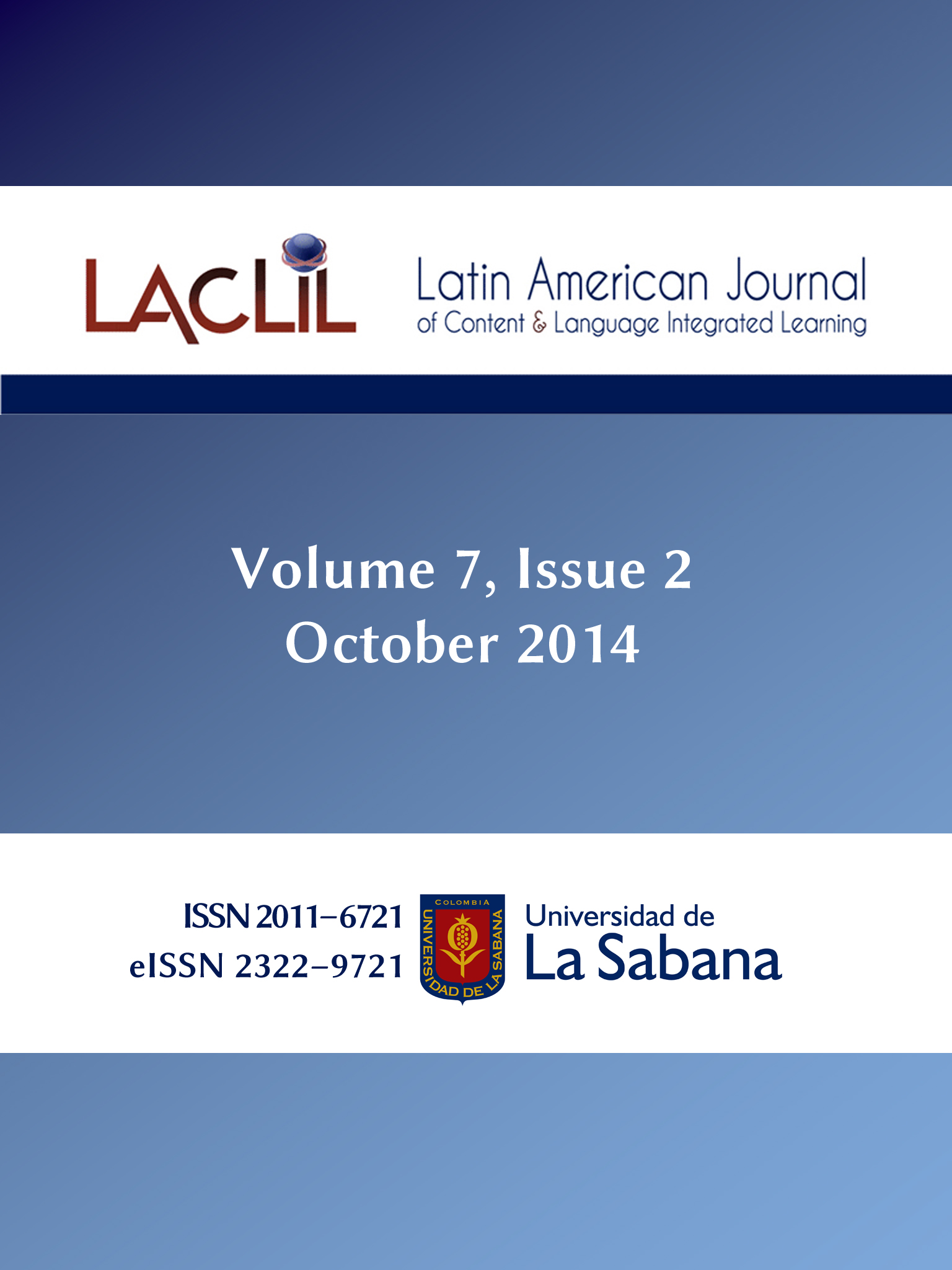Integrating language and content related to different university degree programs
DOI:
https://doi.org/10.5294/4486Keywords:
Autonomy, curriculum development, portfolios, content and language integrated learning, motivation.Abstract
This article shows the description of an experience involving a group of graduate-level university students taking a CLIL (content and language integrated learning) course in Spanish as a foreign language. An important contribution from this study is to show that it is possible to achieve the integration of content and language by incorporating the content of the students’ interests related to the concentrations of their master’s degrees. This group of students is taking a Spanish class at the low and mid-intermediate level (ACTFL, 2012). Their fields of their Master’s programs varied from international policy, to environmental studies, to business. The students had the opportunity to work with content related to their programs over the course of a semester. The instructor used an adaptation of the European Language Portfolio in order to measure part of their performance in class.Downloads
References
ACTFL (2012). ACTFL proficiency guidelines. Recuperado de http://www.actfl.org/publications/guidelines-and-manuals/actfl-proficiency-guidelines-2012].
Arter, J., & Spandel V. (1992). Using Portfolios of Student Work in Instruction and Assessment. Portland, OR: Northwest Regional Education Laboratory.
Bailey, K., & Nunan, D. (2009). Exploring Second Language Classroom Research: A Comprehensive Guide. Kentucky: Cengage.
Benson, P. (2007). Autonomy in language teaching and learning.Language Teaching, 40,21–40.
Breeze, R. (2014). Identifying student needs in English- medium university courses. En Integration of theory and practice in CLIL (pp.143-160). Amsterdam, Nueva York:
Rodopi.
Bruner, J. (1983). Child’s Talk: Learning to use Language Oxford: Oxford University Press.
Carrasco, J., & Calderero Hernández, J. (2000). Aprendo a investigar en educación.RIALP.
Clément, R., & Kruidenier, B. (1983). Orientations in second language acquisition: The effects of ethnicity, milieu, and target language on their emergence. Language Learning, 33, 273-291.
Council of Europe. (2001). Common European framework of reference for language:Learning, teaching, assessment. Cambridge: Cambridge University Press.
Coyle, D., Hood, P., &Marsh, D. (2010). CLIL. Londres: Cambridge University Press.
Crandall, J., & Kaufman, D. (2003). Content-based instruction in Higher Education Settings. Alexandria: TESOL.
Cummins, J. (1989). Empowering minority students. Sacramento: California Associationfor Bilingual Education.
Doughty, C., & Varela, E. (1998). Communicative focus on form. En C. Doughty & J. Williams (Eds.). Focus on form in classroom second language acquisition (pp.114-138). New York: Cambridge University Press.
Dörnyei, Z, &Ushioda, E. (2011). Teaching and researching motivation. Harlow:Longman.
Dörnyei, Z. (2009). The L2 Motivational Self System. En Z. Dörnyei y E. Ushioda (Eds.)Motivation, language identity and the L2 self (pp.9-42). Bristol: Multilingual Matters.
Dörnyei, Z. (2005). The psychology of the language learner: Individual Differences in second language acquisition. Mahwah: Lawrence Erlbaum.
Doiz, A., Lasagabaster, D., & Sierra, J.M. (2013)(Eds). English-Medium Instruction at Universities. Global Challenges. Bristol/Buffalo/Toronto: Multilingual Matters.
Dupuy, B. (2000). Content-based instruction: Can it help ease the transition from beginning
to advanced foreign language classes? Foreign Language Annal, 33, 205-223.
Fortanet-Gómez, I. (2013). CLIL in Higher Education: Towards a Multilingual Language Policy (Bilingual Education and Bilingualism). New York: Multilingual Matters.
Gibbons, P. (2002). Scaffolding Language, Scaffolding Learning: Teaching ESL children in the Mainstream Classroom. Porstmouth, NH: Heinemann.
Gómez Camacho, A. (2013). El aprendizaje integrado de la lengua española y los contenidos de áreas no lingüísticas en los proyectos lingüísticos de centro. Porta Linguarum 20, 103-115.
Grabbe, W., & Stoller, F. (1997). A six T's approach to content based instruction. En M.Snow y D. Brinton. (Eds.). The content-based classroom: Perspectives on integrating language and content (pp. 78-94). New York: Longman.
Hoyos Pérez, M. (2013). La enseñanza integrada de lenguas y contenidos en formación profesional. Revista de Lenguas para Fines Específicos,19,109-145.
Jourdenais, R., & Springer, S. (Eds). (2005). Content Tasks and Projects in the Language Classroom: 2004 Conference proceedings. Monterey, CA: Monterey Institute of
International Studies.
Klenowsky, V. (2012). Desarrollo de Portafolios: para el aprendizaje y la evaluación.Madrid: Narcea, SA.
Lantolf, J., & Thorne, S. (2006). Sociocultural theory and second language acquisition. En W. Van Patten & J. Williams. (Eds.). Theories in second language acquisition (pp.201—224). New Jersey: Erlbaum.
Lasagabaster,D., & Rúiz de Zarobe, Y. (Eds.). (2010). ClIL in Spain; implementations, results and teacher training. Newcastle: Cambridge University Press.
Lyster, R., & Ballinger S. (2011). Content-based language teaching: Convergent concerns across divergent contexts. Language Teaching Research, 15, 279-288.
McDonough, S. (1981). Psychology in foreign language teaching. London: Alien and Unwin.
Nuñez Delgado, M.P., González Vázquez A., & Trujillo Sáez F. (2006). La formación del
profesorado de español como Segunda Lengua. Situación actual y propuestas,Textos de Didáctica de la Lengua y la Literatura, 42, 65-80.
Papai, N. (2000). Literacy development through content-based instruction: A case study.Working Papers in Educational Linguistics, 16, 81-95.
Shaw, P, (1997). With One Stone: Models of Instruction and Their Curricular Implications in an Advanced Content-Based Foreign Language Program. En S.B. Stryker & B. L. Leaver (Eds.). Content-Based Instruction in Foreign Language
Education: Models and Methods (pp.261-282). Washington, D.C.: Georgetown University Press.
Ushioda, E. (2006). Language motivation in a reconfigured Europe: access, identity, autonomy, Journal of Multilingual & Multicultural Development, 27, 148–161.
van Lier, L. (2004). The Ecology and Semiotics of Language Learning: a Sociocultural Perspective. Boston; Dordrecht: Kluwer Academic.
Vygostsky, L. (1978). Problems of Method, Mind in Society. Cambridge, MA: Harvard University Press. 52–75. Trad. M. Cole.
Woźniak, M. (2013). CLIL in Pharmacy: A case of collaboration between content and
language lecturers. Language Value, 5,107-128.
Downloads
Published
How to Cite
Issue
Section
License
This Journal and its articles are published under the Creative Commons CC BY 4.0 DEED Attribution 4.0 International license. You are free to: Share — copy and redistribute the material in any medium or format for any purpose, even commercially. Adapt — remix, transform, and build upon the material for any purpose, even commercially. The license cannot revoke these freedoms as long as you follow the terms of the license.








